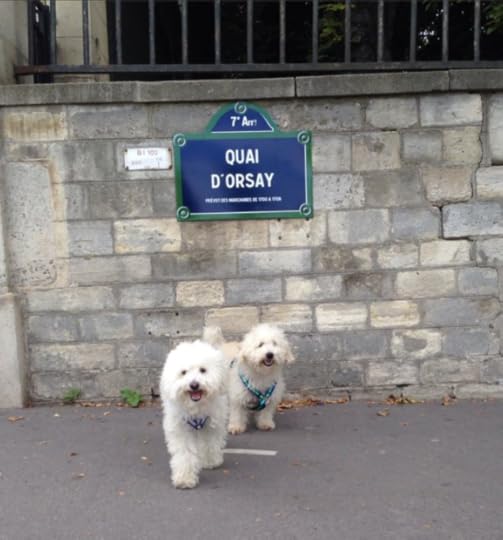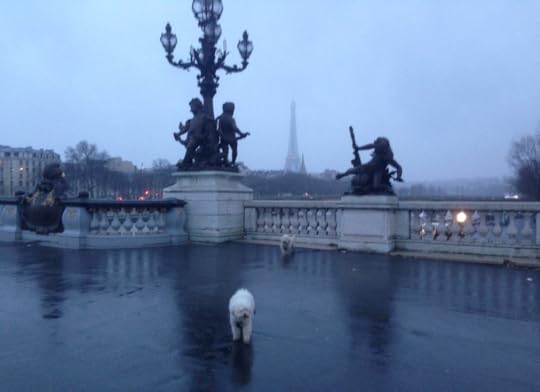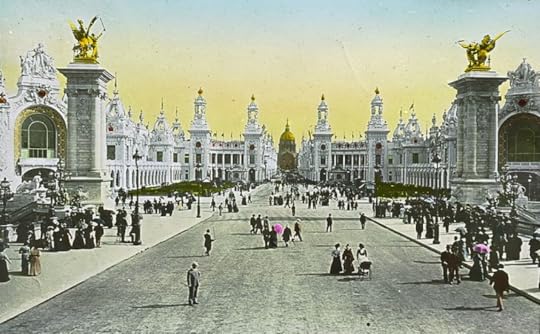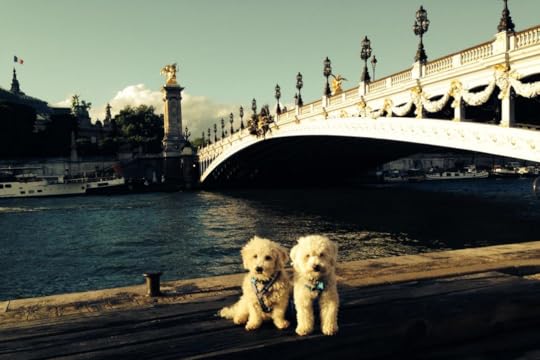Matthew Fraser's Blog: Home Again in Paris
June 3, 2018
Fake News: A Hydra-Headed Monster
Fake news, needless to say, is a big problem. But what is it exactly? According to a recent poll, Americans don’t seem to know. As Politico reported, Americans “cannot even agree on the definition of ‘fake news’.”
The confusion doubtless can be explained by recklessness with which the term is batted about, often to describe very different things, usually as a rhetorical posture. When Donald Trump unleashes a tweet storm blasting the “fake news” media, he targets major news organisations such as the New York Times and CNN. Yet when these established news outlets refer to “fake news”, they usually mean false news stories circulating on social media — in other words, not produced and fact-checked by professionals like themselves. The mainstream media also blame Google and Facebook for spreading fake news stories.
So where does that leave the definition of “fake news”? Trump claims the mainstream media produce “fake news”; but they point the blame elsewhere. Who is right? This mutual blame game renders “fake news” devoid of precise meaning.
Let’s attempt to cut through the name-calling and assign a clear meaning to “fake news”. First, fake news is not a Trump-era phenomenon. Fake news has a long and colourful history in journalism stretching back to the era of bogus foreign correspondents, outlandish newspaper hoaxes, and yellow press sensationalism in the nineteenth century. In today’s digital era, fake news is a hydra-headed beast with many faces. Which doubtless explains why it’s used as a catchall phrase to describe many different things.
Some attempts have been made to classify its meaning, like this one in the Huffington Post which makes an Orwellian allusion by asserting that “some news is more fake than others”. Here is another attempt at a classification: “Fake News: It’s Complicated”.
Below is my attempt at constructing a “fake news” typology. Here are some of the different gargoyle faces on the hydra-headed fake news monster:
First, fake news means news reports that are knowingly, and mischievously, false. These stories are often produced by fake news sites. One example is the story about the Pope endorsing Donald Trump for president. A similar fake news headline was about pop star Taylor Swift: “Taylor Swift Shocks Music Industry: ‘I Voted for Trump’”. Another story claimed Trump had once “groped” drag queen RuPaul at a party — and was furious when he reached up his skirt to discover his male genitals. The story, pure fabrication, attracted more than 300,000 engagements on Facebook. Another Trump fake news story circulated after his election victory. It was reported that President Trump intended to continue as executive producer of the reality TV show, “Celebrity Apprentice”, after moving in to the White House. The story, like the others, was false.
Second, “fake news” can be reports in the mainstream media that are false or inaccurate. An example is CNN’s false report on a Trump adviser’s alleged Russian business ties. Also, ABC News was forced to apologise for a false report claiming that, during the presidential election campaign, Donald Trump had instructed top adviser Michael Flynn to make contact with Russian officials. These are the kinds of stories that Donald Trump, infuriated, blasts as “fake news”. It might be argued, however, that these stories are not “fake” because they were not knowingly false. They were professional lapses. Or as a Poynter story put it, they were “just plain wrong”.
Third, fake news can be manipulated news reports, stories twisted out of context, or phoney photos and videos posted online to create misleading impressions. A Washington Post reporter, for example, tweeted a phoney photo of a near-empty arena with the ironic comment “packed to the rafters” to created the impression that a Trump rally had attracted an embarrassingly small crowd. The photo was phoney. Trump angrily called for the Post reporter to be fired.
Fourth, fake news can be state propaganda inserted into the news system by foreign states. After Donald Trump’s victory, it was claimed that Russians had the manipulated the election outcome through Kremlin-backed agents spreading fake news and buy advertising on Facebook. These practices, widespread during the Cold War, continue in the digital age. One example was a Russian-originated story reporting that WikiLeaks had confirmed that Hillary Clinton, when Secretary of State, sold weapons to the Islamic State. This type of fake news is state disinformation.
Fifth, fake news can be stories that are “spun” by PR firms and advertisers using pseudo news and events to attract publicity and advertising revenues. Like state propaganda, PR and advertising-spun news has been widespread in the mainstream media for the past century. In the digital era, it can be seen on news sites in the form of native advertising and branded content. For example, the New York Times’s branded content unit produces “paid post” marketing campaigns for brands including Philips, Nike and Deloitte. While it’s advertising wrapped in editorial packaging, newspapers like to call it “brand storytelling”. In the pre-digital days of professional journalism, it was called “advertorials” and had a strong stigma attached. In the digital era, with Facebook and Google siphoning the media’s advertising revenue, these “fake” stories are much more common. A virtue is made of necessity.
Finally, fake news is churned out by parody sites such as The Onion which calls itself “America’s finest news source”. Parody sites use outlandish satire to mock the news cycle. Readers are supposed to know that stories are farcical, but serious news organisations routinely get tricked. When The Onionreported that North Korean dictator Kim Jung-Un had been named “Sexiest Man Alive” the story was picked up in the Chinese and South Korean media. Even the New York Times got hoodwinked into publishing a photo of a parody cover of teen magazine Tiger Beat featuring Barack Obama. The New Yorkerfeatures a satirical news column called “The Borowitz Report” which, like The Onion, is often frequently mistaken for real news. While it’s difficult to believe that a headline like “Trump to Split Time Between Trump Tower and the Kremlin” could be interpreted as real, even the New Yorker’s sophisticated readers are sometimes credulous. To make sure readers understand that the “Borowitz Report” is satire, the New Yorker changed the column’s tagline from “The News, Reshuffled” to “Not the News”.
The simple classification above — it undoubtedly can be nuanced — demonstrates that “fake news” comes in many forms. Most of us believe we understand what “fake news” means. In truth, it often means what people want it to mean.
The post Fake News: A Hydra-Headed Monster appeared first on Matthew Fraser.
August 6, 2017
Self-Portrait at Home: In a Mirror, Darkly
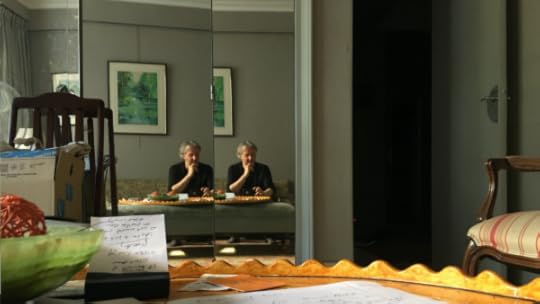 At home, in a mirror, darkly
At home, in a mirror, darklyThe post Self-Portrait at Home: In a Mirror, Darkly appeared first on Matthew Fraser.
Titi, My Lodger This Summer

Meet Titi, my lodger this summer, she fell from a nest into my courtyard in early June.
The post Titi, My Lodger This Summer appeared first on Matthew Fraser.
Hector & Hugo, Afternoon Walk, Paris
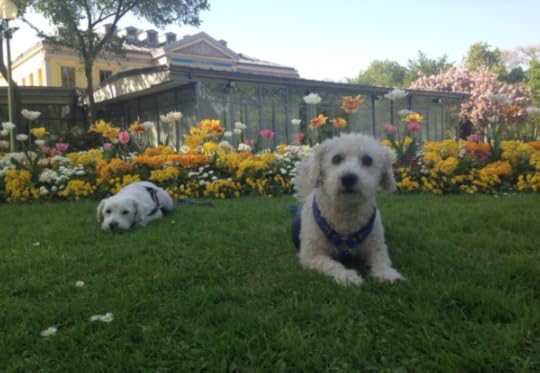
Hector and Hugo behind Le Doyen just off the Champs-Elysées.
The post Hector & Hugo, Afternoon Walk, Paris appeared first on Matthew Fraser.
February 21, 2016
Calais, from Field of Gold to the Jungle
The whole world has now heard of Calais, an otherwise monotonous, pigeon-skied patch of northern France afflicted with the geographical misfortune of being the closest point along the coastline to the white cliffs of Dover across the English Channel.
Calais has become France’s shame. We have watched with mounting consternation television news reports showing crowded and fetid campments — the “Calais jungle” — where migrants are so desperate to reach the UK that many have committed reckless and violent acts, from storming the Eurotunnel and occupying ferry boats to violently clashing with French police. To some observers, the migrants are dangerous hordes whose motives are uncertain; to others, they are refugees fleeing distant wars and crying out for help. Critics of France’s treatment of the refugees lament that the great French republic, once the cradle of the Enlightenment, has turned its back on the sorry plight of these people living in misery on French territory. As the New York Times put it, after the Calais crisis France today is “Paradise Lost“.
[image error]The patience of the locals in Calais, forced to endure this international crisis every day, is quickly running out. The people of Calais have been mistreated by history. Their region in northern France — called “le nord” — is regarded by many French as poor and backwards, an industrial rustbelt eroded by unemployment and alcoholism. The region was devastated by two world wars in the last century — and in the 19th century, by the Franco-Prussian War. In less than a hundred years, the German army rolled over the region three times. Flanders fields are just to the east. The battle of Dunkirk in 1940 was fought on Calais’ beaches. After the war, the coal mines closed, pushing the Pas-de-Calais population into poverty and depression.
One fact about Calais that history has almost forgotten is that it was once English. Calais was the last parcel of English land ceded to France. That happened in 1558, a date that marked the end of English territorial control on the continent following the Hundred Years War. Five hundred years ago, if you were standing on the territory where the muddy migrant camps are festering today, you would have been on English soil. When the English lost Calais, it was a great shock.
Calais’ most glorious moment in history was in 1520. That year, Europe’s two great monarchs — England’s Henry VIII and France’s François I — met in Calais for an extravagant two-week Renaissance summit. Both monarchs were the rock stars of the age, which doubtless explained why they regarded each other with mutual fascination and jealousy. They had no reason to trust each other. France and England were rivals, though they shared a mutual distrust of the Holy Roman Emperor, Charles V (who was also King of Spain). That’s precisely why Henry and François agreed to meet in Calais. The summit was organised to celebrate a sort of non-aggression pact between England and France. Henry VIII insisted that the summit be held in Calais so he could claim he had never left English soil. Calais belonged to his realm.
Henry VIII arrived in Calais in June 1520 with a retinue of 500 horsemen and more than 3,000 foot soldiers. He was a young man in 1520, still fit and vigorous at 29, not yet the grotesquely obese figure of later years. François I, a prodigious seducer of women, was younger than Henry and even more physically energetic. Each monarch had temporarily palaces constructed in Calais for their respective courts.
The 1520 Anglo-French summit was so sumptuous that its precise location has come down to us in the annals of history with a name that leaves no doubt about its extravagance: Field of the Cloth of Gold, so named for the dazzling royal tents with their marquees of gold cloth. The two-week event (see painting above) featured lavish feasts, music performances, and jousting tournaments. Nearly 3,000 tents were erected for the large retinue and guests. In total, Henry brought 4,000 servants and 2,000 horses. Henry’s queen, Spanish-born Catherine of Aragon, had in her company more than 1,000 servants and 800 horses. It is estimated that the entire English contingent counted 6,000 noblemen, women and servants; and that François I’s party was of similar size. More than 2,000 sheep were eaten during the feasts. Pungent claret flowed from golden fountains.
For two kings celebrating a peace treaty, the summit featured a great deal of ritualised aggression. Both Henry and François personally competed in the jousting spectacles — and both broke their lances several times. Henry was outfitted majestically, his armour skirt and horse trapper covered in gold and pearls. One of the jousts was so violent that François I broke his nose. He took his revenge on the English monarch later in a wrestling match, quickly putting Henry to the ground. Henry was reported to have been so furious that he stormed off sulking.
As a political event, the Field of Gold Cloth summit failed to produce lasting peace in Europe. The very next year, England and France were at war again after Henry VIII sided with Charles V against François I. The English and French monarchs were to meet once more in Calais, however. In 1532, Henry crossed the Channel again, this time with Anne Boleyn, to enlist François I’s support in persuading the Pope to grant an annulment of Henry’s marriage to Catherine of Aragon. François I refused to meet Anne, however, as she was merely Henry’s mistress. And as for the papal annulment, that didn’t go as planned either. Both Henry and François died in the same year, 1547 — Henry on January 28, François on March 31.
[image error]The glorious Anglo-French summit of 1520 took place just south of modern-day Calais, not far from the Eurotunnel entrance protected today by police and high fences. Today the Calais jungle counts some 3,5oo refugees, including 445 children, still waiting for their chance to cross the Channel and start a new life. But the UK government doesn’t want them either. That attitude that may well be hardened after Britons vote in a referendum about leaving the European Union. Meanwhile, the refugees fear eviction by French authorities, while film stars such as Jude Law and Benedict Cumberbatch campaign to have the refugee children reunited with their families in the UK.
How cruelly ironic for the thousands of refugees trapped in Calais. Five centuries ago, Calais was English soil.
(Photo: Daily Mail/AP)
The post Calais, from Field of Gold to the Jungle appeared first on Matthew Fraser.
When Calais Was English: The 1520 Anglo-French Summit
The whole world has now heard of Calais, an otherwise monotonous, pigeon-skied patch of northern France afflicted with the geographical misfortune of being the closest point along the coastline to the white cliffs of Dover across the English Channel.
Calais has become France’s shame. We have watched with mounting consternation television news reports showing crowded and fetid campments — the “Calais jungle” — where migrants are so desperate to reach the UK that many have committed reckless and violent acts, from storming the Eurotunnel and occupying ferry boats to violently clashing with French police. To some observers, the migrants are dangerous hordes whose motives are uncertain; to others, they are refugees fleeing distant wars and crying out for help. Critics of France’s treatment of the refugees lament that the great French republic, once the cradle of the Enlightenment, has turned its back on the sorry plight of these people living in misery on French territory. As the New York Times put it, after the Calais crisis France today is “Paradise Lost“.
[image error]The patience of the locals in Calais, forced to endure this international crisis every day, is quickly running out. The people of Calais have been mistreated by history. Their region in northern France — called “le nord” — is regarded by many French as poor and backwards, an industrial rustbelt eroded by unemployment and alcoholism. The region was devastated by two world wars in the last century — and in the 19th century, by the Franco-Prussian War. In less than a hundred years, the German army rolled over the region three times. Flanders fields are just to the east. The battle of Dunkirk in 1940 was fought on Calais’ beaches. After the war, the coal mines closed, pushing the Pas-de-Calais population into poverty and depression.
One fact about Calais that history has almost forgotten is that it was once English. Calais was the last parcel of English land ceded to France. That happened in 1558, a date that marked the end of English territorial control on the continent following the Hundred Years War. Five hundred years ago, if you were standing on the territory where the muddy migrant camps are festering today, you would have been on English soil. When the English lost Calais, it was a great shock.
Calais’ most glorious moment in history was in 1520. That year, Europe’s two great monarchs — England’s Henry VIII and France’s François I — met in Calais for an extravagant two-week Renaissance summit. Both monarchs were the rock stars of the age, which doubtless explained why they regarded each other with mutual fascination and jealousy. They had no reason to trust each other. France and England were rivals, though they shared a mutual distrust of the Holy Roman Emperor, Charles V (who was also King of Spain). That’s precisely why Henry and François agreed to meet in Calais. The summit was organised to celebrate a sort of non-aggression pact between England and France. Henry VIII insisted that the summit be held in Calais so he could claim he had never left English soil. Calais belonged to his realm.
Henry VIII arrived in Calais in June 1520 with a retinue of 500 horsemen and more than 3,000 foot soldiers. He was a young man in 1520, still fit and vigorous at 29, not yet the grotesquely obese figure of later years. François I, a prodigious seducer of women, was younger than Henry and even more physically energetic. Each monarch had temporarily palaces constructed in Calais for their respective courts.
The 1520 Anglo-French summit was so sumptuous that its precise location has come down to us in the annals of history with a name that leaves no doubt about its extravagance: Field of the Cloth of Gold, so named for the dazzling royal tents with their marquees of gold cloth. The two-week event (see painting above) featured lavish feasts, music performances, and jousting tournaments. Nearly 3,000 tents were erected for the large retinue and guests. In total, Henry brought 4,000 servants and 2,000 horses. Henry’s queen, Spanish-born Catherine of Aragon, had in her company more than 1,000 servants and 800 horses. It is estimated that the entire English contingent counted 6,000 noblemen, women and servants; and that François I’s party was of similar size. More than 2,000 sheep were eaten during the feasts. Pungent claret flowed from golden fountains.
For two kings celebrating a peace treaty, the summit featured a great deal of ritualised aggression. Both Henry and François personally competed in the jousting spectacles — and both broke their lances several times. Henry was outfitted majestically, his armour skirt and horse trapper covered in gold and pearls. One of the jousts was so violent that François I broke his nose. He took his revenge on the English monarch later in a wrestling match, quickly putting Henry to the ground. Henry was reported to have been so furious that he stormed off sulking.
As a political event, the Field of Gold Cloth summit failed to produce lasting peace in Europe. The very next year, England and France were at war again after Henry VIII sided with Charles V against François I. The English and French monarchs were to meet once more in Calais, however. In 1532, Henry crossed the Channel again, this time with Anne Boleyn, to enlist François I’s support in persuading the Pope to grant an annulment of Henry’s marriage to Catherine of Aragon. François I refused to meet Anne, however, as she was merely Henry’s mistress. And as for the papal annulment, that didn’t go as planned either. Both Henry and François died in the same year, 1547 — Henry on January 28, François on March 31.
[image error]The glorious Anglo-French summit of 1520 took place just south of modern-day Calais, not far from the Eurotunnel entrance protected today by police and high fences. Today the Calais jungle counts some 3,5oo refugees, including 445 children, still waiting for their chance to cross the Channel and start a new life. But the UK government doesn’t want them either. That attitude that may well be hardened after Britons vote in a referendum about leaving the European Union. Meanwhile, the refugees fear eviction by French authorities, while film stars such as Jude Law and Benedict Cumberbatch campaign to have the refugee children reunited with their families in the UK.
How cruelly ironic for the thousands of refugees trapped in Calais. Five centuries ago, Calais was English soil.
(Photo: Daily Mail/AP)
The post When Calais Was English: The 1520 Anglo-French Summit appeared first on Matthew Fraser.
January 11, 2016
For Parisians, Shock is Solidarity
Below is my column for CNN.com in the aftermath of the terrorist attacks in Paris (for link click here).
One week after the terrorist attacks, the world is crying for Paris. The City of Light, which evokes romance and inspires dreams, has been darkened by a terrifying nightmare. The night after the attacks, the lights on the Eiffel Tower went black in mourning.
Yet Parisians, refusing to succumb to despair, are showing the strength of their resilience. Yes, nervous tourists are canceling travel plans to the French capital. And those who are already here are staying clear of monuments like Notre Dame, fearing they might be terrorist targets. But Parisians themselves are defiantly flooding back into their local bistrots and onto café terraces, savoring the movable feast that is Paris. Precisely what the jihadists loathe and fear.
As a longtime resident of Paris, this aspect of the Parisian character has always impressed me. Parisians, often considered by foreigners as unsmiling and inhospitable, are astoundingly courageous in the face of adversity. Emboldened by their legendary pride, Parisians refuse to be rattled.
In many respects, it shouldn’t be so surprising. The Parisian saga has been tumultuous for centuries. Tragic violence is part of the city’s collective narrative. Parisians are blessed with the most beautiful city in the world, but they are also battered by history’s cruelest ordeals.
It is often forgotten that Paris was brought to its knees during the four-month Prussian siege of 1870-71. The Prussian army surrounded the French capital and shelled the city mercilessly. As the siege dragged on, Parisians were so starved that they desperately slaughtered thousands of horses and killed dogs, cats, and even rats for food. Even the animals in the Paris zoo were killed for food.
The pounding Prussian shells, and the destruction that followed during the rebellious Commune, disfigured destroyed much of the city. Some 47,000 civilians were killed, 12,000 from diseases. The Tuileries Palace, burnt to the ground, was reduced to a pile of rubble.
The German occupation of Paris in 1940 marked the darkest period in the city’s history. Thousands of Jews were rounded up and deported to Nazi concentration camps. After the war, many Parisians turned on Nazi collaborators in a bloodbath of purges. That episode was so traumatic that its worst horrors were swept under the collective carpet for a generation.
Forty years later, I was a young student in Paris in the 1980s when terrorist bombs shattered the city. The series of blast in 1986 were much like the most recent attacks in this city, though three decades ago the perpetrators were remote-controlled by Hezbollah in Lebanon. The entire city was on edge throughout 1986 as blast after blast — plastic Semtex bombs placed in public trash cans — ripped through the capital. In September, a bomb explosion in front of a discount clothing store in Montparnasse killed seven people and left 55 injured. Bodies were splayed on the pavement like broken puppets with limbs missing.
In the weeks that followed, it was impossible to enter a Monoprix to go shopping for groceries without passing through airport-level security. Since that tragedy, public trash poubelles in Paris are made of transparent green plastic so bombs placed in them are visible.
In the mid-1990s when I was completing my doctorate in Paris, another series of attacks rocked Paris. This time the terrorists were Algerian Islamists. Eight attacks occurred that year — including one in the Paris Métro near Notre Dame — killing eight and wounding more than 200. At the time, it felt like the terrorist violence would never end in Paris.
The Charlie Hebdo massacre in January this year was like a horrifying nightmare returning after two decades. The terrorists are still Islamic fanatics taking orders from Daesh leaders in Syria. The sponsors were different, the target was the same — Paris.
And now, less than a year later, the city has been struck again. The terrorist attacks a week ago were the worst to hit Paris. Paris has not suffered this kind of collective trauma since the Second World War. Again, the perpetrators are Islamic fanatics striking at the city that is the symbol of Western culture and secular values.
This time, the violence is so horrifying that the French government has declared war on the terrorists. The French army is bombing terrorist strongholds in Syria where these atrocities originate. It won’t be a quick war and an easy victory. Parisians know the city will continue to be a target as French bombs fall on Syrian soil.
Perhaps that explains why Parisians have thrown themselves with a vengeance back into the fleeting joys of their daily lives.
In Paris, we have seen this before. And, as in the past, Parisians will triumph by the force of their stubborn zest for life. Shock is now solidarity.
The post For Parisians, Shock is Solidarity appeared first on Matthew Fraser.
February 26, 2015
Hector and Hugo on their own street in Paris, 7th arrond...
Hector and Hugo on their own street in Paris, 7th arrondissement, this sign just next to the Assemblée Nationale.
The post appeared first on Matthew Fraser.
December 25, 2014
Christmas Eve 2014 in Paris
Hugo & Hector, born in Los Angeles, spend their first Christmas in Paris. Photo taken Christmas Eve on the Alexandre III bridge.
The post Christmas Eve 2014 in Paris appeared first on Matthew Fraser.
July 26, 2014
How the First World War Began Just Outside My Door on the Alexandre III Bridge
It is frequently observed, including by many Parisians, that the Pont Alexandre III is the most beautiful bridge in Paris.
Adorned with exquisite Art Nouveau-style lamp posts and embellished with nymphs and cherubs, the bridge elegantly arches over the Seine as a vast avenue connecting the Grand Palais and Les Invalides. It has become legendary in the popular imagination, made famous in films from James Bond’s A View to Kill to Woody Allen’s Midnight in Paris; recognised as the glamorous backdrop in chic fashion shoots; and recently used as the setting in Adèle’s video for her song, “Someone Like You”.
I live about two hundred yards from the Alexandre III bridge. From my windows I can see its gold-tipped columns. I cross the bridge on walks with Hugo and Hector almost every evening, stopping mid-way to take in the magnificent view of the Eiffel Tower sparkling against the purple night.
Occasionally, a friend visiting Paris asks me: “Who was Alexandre III anyway?” An obvious question, though I’m not sure most Parisians know the answer. Or know that the Alexandre III bridge can help us understand the origins of the First World War.
Next week the world commemorates the outbreak of the Great War, as it was long known. It’s often claimed, and generally accepted, that the First World War was triggered by the assassination of Austro-Hungarian Archduke Franz Ferdinand by Serbian nationalist Gavrilo Princip. It’s a simplistic explanation, but has some mechanical truth to it given that the assassination caused Austria-Hungary to declare war on Serbia, setting in motion an infernal domino effect.
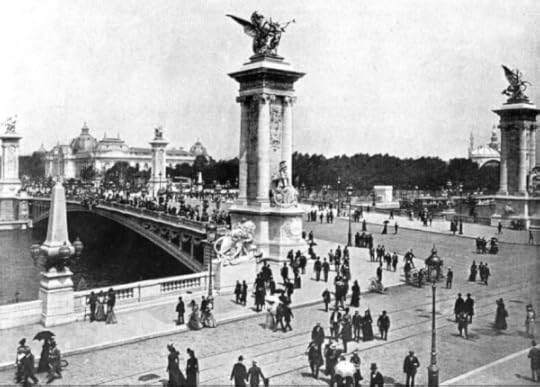 But the historical backstory that led to the outbreak of the First World War was a much more fatally complex saga. And the first act of that ill-fated drama began just down the road from me — on the Alexandre III bridge.
But the historical backstory that led to the outbreak of the First World War was a much more fatally complex saga. And the first act of that ill-fated drama began just down the road from me — on the Alexandre III bridge.
The bridge was named after Tsar Alexander Romanov, Emperor of Russia, King of Poland, and Grand Prince of Finland. Alexander III (pictured below with his wife Dagmar of Denmark) was a massive, hulking man who had the rough manner of the largely peasant population over which he ruled. He was known as “the Peacemaker” because Russia fought no wars during his reign at the end of the 19th century.
Alexander III died in time to miss two catastrophic events that changed the course of history. And yet he played a role in shaping both. The first was the World War I, which began exactly one hundred years ago this coming week. The second was the collapse of the Russian empire and the execution of his son and heir, Nicholas II, along with his entire family.
Alexander III’s connection with the famous Parisian bridge that bears his name was posthumous. When construction began in 1896, he had had been dead for two years. The Russian tsar had died suddenly of kidney disease in 1894 at the relatively young age of 49, thrusting his inexperienced son Nicholas II into a role for which he was neither prepared nor suited.
It was Nicholas II who came to Paris in 1896 to preside over the ceremonies baptising the new bridge in honour of his late father. When laying the first stone on the bridge, Nicholas II was in fact cementing a political alliance between Russia and France negotiated by his father. At the same time, a similar Trinity Bridge was being constructed in St. Petersburg as a reciprocal gesture to mark the Franco-Russian alliance. That bridge was designed by Gustave Eiffel, famous for his tower erected less than a decade earlier for the Paris World Fair in 1889.
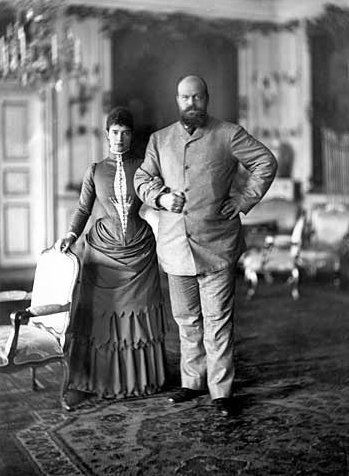 France had self-interested reasons for seeking closer relations with Russia. In the 1890s the Third Republic was still lurching unsteadily forward in the aftershock of the Franco-Prussian War, which had dealt a devastating blow to the French nation. France had foolishly declared war on Prussia in 1870 — and suffered a quick and humiliating defeat. The Prussians had sieged the French capital, driving Parisians to starvation and provoking the civil war bloodshed of the Paris Commune in 1871. The war also gave Bismarck a pretext to consolidate Prussian power over a newly born German nation, which now included French territories Alsace and Lorraine.
France had self-interested reasons for seeking closer relations with Russia. In the 1890s the Third Republic was still lurching unsteadily forward in the aftershock of the Franco-Prussian War, which had dealt a devastating blow to the French nation. France had foolishly declared war on Prussia in 1870 — and suffered a quick and humiliating defeat. The Prussians had sieged the French capital, driving Parisians to starvation and provoking the civil war bloodshed of the Paris Commune in 1871. The war also gave Bismarck a pretext to consolidate Prussian power over a newly born German nation, which now included French territories Alsace and Lorraine.
Vulnerable and diplomatically isolated, France desperately needed friends and allies in the face of German belligerence. The obvious candidate was Tsar Alexander III, who just happened to despise Otto von Bismarck. Alexander III also needed access to European capital markets to spur economic growth in his largely agricultural empire.
The conditions of mutual self-interest were ripe for a Franco-Russian alliance. France won a military ally; and Russia gained access to cheap loans on the Paris bourse. French elites extended their generosity by bribing much of the Parisian press to promote Russian bonds in their pages as the great story of the day.
It was an intriguing contrast to events today more than a century later. François Hollande and David Cameron, embarrassed by their commercial relations with Russia, are exchanging barbs while accusing the other of selling arms to Vladimir Putin’s ugly regime. At the end of the 19th century, Russia was a strategic ally to both France and Britain in the face of the Teutonic alliance bonding Germany and Austria-Hungary.
The terms of the Franco-Russian alliance were clear: if Germany or Austria-Hungary attacked Russia or France, the other ally would mobilise its army. France committed 1.3 million troops, Russia was ready with 800,000 soldiers.
The assassination of Franz Ferdinand was a distant shot nearly two decades away when Nicholas II was laying the cornerstone on the Pont Alexandre III. The Belle Époque was at its apogee in 1896. The Alexandre III bridge was the architectural centrepiece of the Exposition Universelle that opened four years later in 1900. The bridge, along with the Grand Palais, is one of the few remaining architectural vestiges of that glorious event that brought the entire world to the French capital.
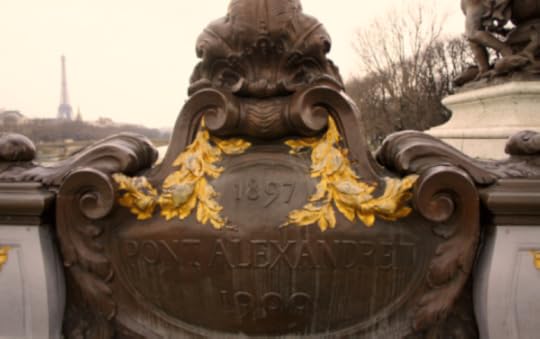 The Exposition Universelle of 1900, the first international showcase of the Art Nouveau style, was an extravagant Belle Époque bash that brought the civilised world to Paris in a great burst of cultural and technological self-congratulation. It was at that event that marvels such as the escalator and talking films were first unveiled. Oscar Wilde, living in Paris in 1900, attended the fair and recited a verse from his poem “The Ballad of Reading Gaol” on a new-fangled sound recording machine. National pavilions adorned the banks of the Seine like ornate wedding cakes almost Disneyland-like in their opulence.
The Exposition Universelle of 1900, the first international showcase of the Art Nouveau style, was an extravagant Belle Époque bash that brought the civilised world to Paris in a great burst of cultural and technological self-congratulation. It was at that event that marvels such as the escalator and talking films were first unveiled. Oscar Wilde, living in Paris in 1900, attended the fair and recited a verse from his poem “The Ballad of Reading Gaol” on a new-fangled sound recording machine. National pavilions adorned the banks of the Seine like ornate wedding cakes almost Disneyland-like in their opulence.
When the Exposition Universelle was over, Paris stood resolutely at the centre of modern civilisation. In the following decade the French capital boasted the greatest writers, artists and composers of the day – Marcel Proust, Picasso, Matisse, Modigliani, Erik Satie, Stravinsky. Gertrude Stein established her Left Bank salon in 1903.
But dark clouds were gathering over Europe. The Exposition Universelle had marked the strutting high point of an epoch whose narcissistic grandeur would soon plummet into irrational folly. An entire order was about to be swept away.
When Gavrilo Princip shot Franz Ferdinand in late June 1914, Serbia was an ally of Russia. Austria-Hungary quickly declared war on Serbia. Tsar Nicholas II immediately mobilised his army, provoking Germany to declare war on Russia on August 1, 1914. Three days later, France – by the terms of its alliance with Russia — was dragged into the war. The following day, Britain too was at war with Germany. The death toll when the war finally ended four years later: nearly 20 million.
Next week when I’m taking evening walks across the Alexandre III bridge with Hugo and Hector, and stopping to behold the magnificent vista of the illuminated Seine, I will be reminded that it was here where, symbolically, the cornerstone of the First World War was laid.
The post How the First World War Began Just Outside My Door on the Alexandre III Bridge appeared first on Matthew Fraser.
Home Again in Paris
- Matthew Fraser's profile
- 24 followers



